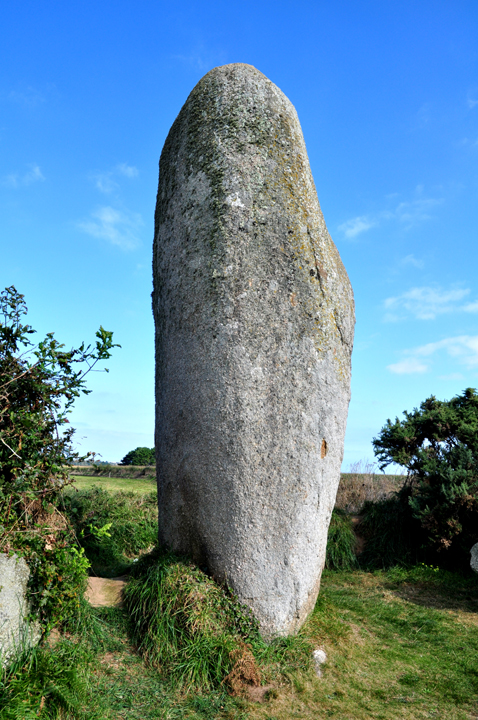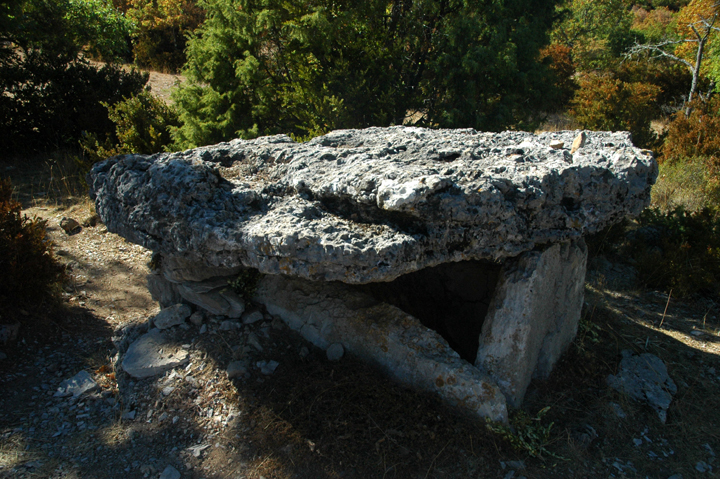



Sunday 27.09.2009 Pano from east autostitch.net



Saturday 26.09.2009 Because of the light, this is my only photo vaguely showing one of the lumps/bosses/bumps that people used to rub their bits against to ‘ensure’ fertility




Saturday 26.09.2009 Access has been maintained while in crop – wish this was more common!








Saturday 26.09.2009 Pano by autostitch.net free beta version





Saturday 26.09.2009 An unreachable whopper, it seems
Access: Amongst labyrinthine country roads. The stone lies near the centre of a field is all I can say – see below....
Visited Saturday 26 September 2009
First one of the holiday. In crop. Bugger.
Some proper pics here, under Plouguin in the horizontal dropdown menu of villages across the top of the page. (Couldn’t find a way to link to the particular page.)

Monday 27 October 2008 Julian Cope and band play on Swanborough Tump as part of Julian’s ‘busking tour’ – I figured the fact that this is Julian’s website meant TMA Eds may allow this as an acceptable post....



Wednesday 5 September 2007 Is that another very tall thin stone ‘above’ and to the right of the main stone in the photo?

Wednesday 5 September 2007 I wish we’d had time for a closer look....

Wednesday 5 September 2007 Viewed from the road with a very big lens
Approximate long/lat coordinates only
Access: See the Menhir de Cisternette and Menhir 1 de Coulet. Less than 300 metres east, on the north side of the road. Also less than 1km east of the Menhir de la Levade.
As with all the menhirs here, there is a fence at the side of the road, so I’m not sure how easy it is to get right up to the stone, but it’s very close to the road.
‘Visited’ Wednesday 5 September
One web source I have seen since we got back suggests that there are two menhirs here, but gives no more information.
We could only see one from the road, though looking closely at one my photographs there is what I had previously taken as a dead tree beyond the stone. I now think it could well be another stone. The one we definitely saw is a fairly chunky, tapering monolith around 3 metres tall and 1.5 metres wide. As with Menhir 1 du Coulet, it is set on the high plain surrounded by low hills.

Wednesday 5 September 2007 If those deep cuts/cracks are the alleged ‘christianisation’ carving, I’m not convinced!
Approximate long/lat coordinates only
Access: See the Menhir de la Cisternette. This one is right opposite, on the north side of the road, but ‘Cisternette’ is probably easier to spot (it’s unmissable!) Also only about 600 metres east of the Menhir de la Levade and less than 300 metres west of the Menhir 2 (?) du Coulet.
As with all the menhirs here, there is a fence at the side of the road, so I’m not sure how easy it is to get right up to the stone, but it’s very close to the road.
‘Visited’ Wednesday 5 September
A nice-looking, slim monolith 3.25 metres tall and 1.35 metres wide, set on the high plain surrounded by low hills.
Approximate long/lat coordinates only
Access: See the Menhir de la Levade. The Menhir de Cisternette is easy to spot and the only one of the four menhirs we found that is to the right (south) of the road. Heading east on the D130, it is only about 600 metres past the Menhir de la Levade, which is on the left (north) of the road. (Less than 300 metres west of the Menhir 2 du Coulet).
The Menhir 1 du Coulet is to the north of the road at the same point, but is probably harder to spot while moving....
As with all the menhirs here, there is a fence at the side of the road, so I’m not sure how easy it is to get right up to the stone, but it’s very close to the road.
‘Visited’ Wednesday 5 September
This one’s a fairly beefy slab of a stone, 2.3 metres tall. It’s set on the low slopes of the hillside surrounding the open high plain.
Some marks on its north face have apparently been interpreted as a possible cross and attempt at christianisation. I’m not convinced, myself.
Approximate long/lat coordinates only
Access: For directions, see the Petit Dolmen de Ferrussac. Heading east from the Petit dolmen, we spotted four menhirs from the road. In order, they were this one (on the left/north of the road), the Menhir de la Cisternette (on the right/south), Menhir 1 du Coulet (on the left/north) and one which I guess is Menhir 2 (?) du Coulet (on the left/north).
Starting from the Petit Dolmen, go east on the D130 past the Grand Dolmen de Ferrussac. After passing the Grand Dolmen, once the countryside ‘opens up’ on the left, keep your eyes open (on both sides) for menhirs.
I say look out on both sides because if you miss this one, the next one is the Menhir de la Cisternette on the right. As that’s the only one we saw on the right, it is very helpful in working out where you are in relation to the others!
The Menhir de la Levade is around 3km east of the Grand Dolmen on the left (north) of the road. There is a fence at the side of the road, so I’m not sure how easy it is to get right up to the stone, but it’s easy to see from the road once you spot it.
‘Visited’ Wednesday 5 September
Despite being 3 metres tall, we only just spotted this one in the scrub on the plain. But if you miss it, it would be easy to find by retracing your steps/wheeltracks from the Menhir de la Cisternette, which is very easy to spot on the right (south) of the road a little further along. We didn’t stop, as we had traffic behind and weren’t planning to stop at single stones....
I now regret this, as from the glimpse we got it looks like a fine menhir. Admittedly it seemed very much like the others on the D130, which we did get a chance to stop at and photograph.

Wednesday 5 September 2007 Le Petit dolmen encloses un plus petit dolmen....




Wednesday 5 September 2007 From the side of the D130

Wednesday 5 September 2007 A giantess or a tiny dolmen? You decide....
Access: Just visible through trees from the D130. For this one and many others very near by, leave the A75 at junction 52 and take the D25 through St Etienne-de-Gourgas and St Pierre-de-la-Fage. From St Pierre, continue for around 1.5km, taking a right fork south, to La Vacquerie(-et-St-Martin-de-Castries) on the D9.
Pass through the village and carry on for a short distance to the D130 left (east). Take this for around 2km, probably a bit less, keeping you eye out for a glimpse of a dolmen in the trees to the left (north) of the road. You may also spot a ruined tumulus. (We didn’t, but I forgot to look for it.)
Visited Wednesday 5 September
Wow, what a dinky dolmen! I’d assumed it was just called that to distinguish it from the Grand Dolmen!
Standing in the remnants of its mound, this is a more ‘standard-looking’ structure than the Grand Dolmen just up the road. It appeared to us to have traces of a passage.
Actually, we would probably have missed it if not for an elderly French couple we met when we overshot to the Grand Dolmen, who managed clarify Bruno Marc’s directions in Dolmens et Menhirs en Languedoc et Roussillon, despite our pidgin French and them not speaking any English....
And inside the tiny dolmen was an even tinier ‘model’ dolmen. We saw loads of these in the south of France, near real ones. Must be a local megalith-spotter hobby. I’ve only ever seen a couple in this country (& a tiny model stone circle on the path to a stone circle in County Cork).
In the area there is also a huge necropolis (at La Roque aka Laroque) and there are a couple of other more ruined dolmens very near St Pierre-de-la-Fage. The St Pierre dolmens are covered in the Bruno Marc book mentioned above. The necropolis is covered in his snappily titled Statues-Menhirs et Dolmens des Sausses et du Haut Languedoc. We didn’t have time for everything and chose to target what seemed the more striking places.

Wednesday 5 September 2007 The ‘double-dolmen’ appearance and the elderly couple who helped us realise we’d missed the Petit Dolmen de Ferrusac


Wednesday 5 September 2007 Approaching from the road

Wednesday 5 September 2007 The uppermost part of the chamber, looking like a large but ‘standard-type’ dolmen (and hiding the sins of the other, concrete, side slab)
Access: See the Petit Dolmen de Ferrusac (which we would probably have missed if not for an elderly couple we met at the Grand Dolmen!) The Grand Dolmen is around 300 metres further along, also on the left. Reasonably easily visible through bushes and small trees from the D130.
Visited Wednesday 5 September
Like the similar Dolmen 1 de Coste-Claude, this one had been fascinating us ever since we saw a photo, as it looks like a double-decker dolmen! As with Coste-Claude, it’s actually a passage grave where the chamber is considerably taller than the passage, creating a strange overall impression.
A very impressive monument, noticably larger than Coste-Claude, slightly ‘tattier’ and marred somewhat by a concrete slab used to replace one of the side slabs of the upper part of the chamber.
There are several outcrops of rock immediately to the north of the dolmen, and even some suitable slabs of rock that could surely have been used instead, but I dare say there are reasons why concrete was used....
Perhaps those slabs may be the remnants of other monuments? In Dolmens et Menhirs en Languedoc et Rousillon, Bruno Marc certainly says that there is a menhir in the trees behind, 50 metres to the NW and another (fallen and broken in two) 80 metres to the NE. Not sure if he means 80 metres from the dolmen or from the from the ‘50 metre’ menhir.... We didn’t have time to go looking.
There are certainly several menhirs to the east – 4 that we found: Menhir de la Levade, Menhir de la Cisternette, Menhir 1 du Coulet and one which I guess is Menhir 2 (?) du Coulet.
With the Petit Dolmen just down the road, the area seems to have been a fair old complex of monuments.

Wednesday 5 September 2007 Note the light shining through the upper part of the chamber into the lower, showing that there is nothing between it and the lower part

Wednsday 5 September Nasty concrete slab in foreground – shame they couldn’t’ve used one of the huge slabs of rock amongst the trees behind....

Wednesday 5 September 2007 A bit trashed....
Access Just 85 metres SE of Dolmen 1 de Coste-Claude. See Dolmen 1 de Coste-Claude for details of how to reach the dolmens.
Visited Wednesday 5 September
Quite ruined, but probably worth a look if you’re visiting Dolmen 1. There is also another even more ruined dolmen nearby. Again, see Dolmen 1 de Coste-Claude.